Posted in Научное оборудование
FTIR spectrometer IRPrestige-21
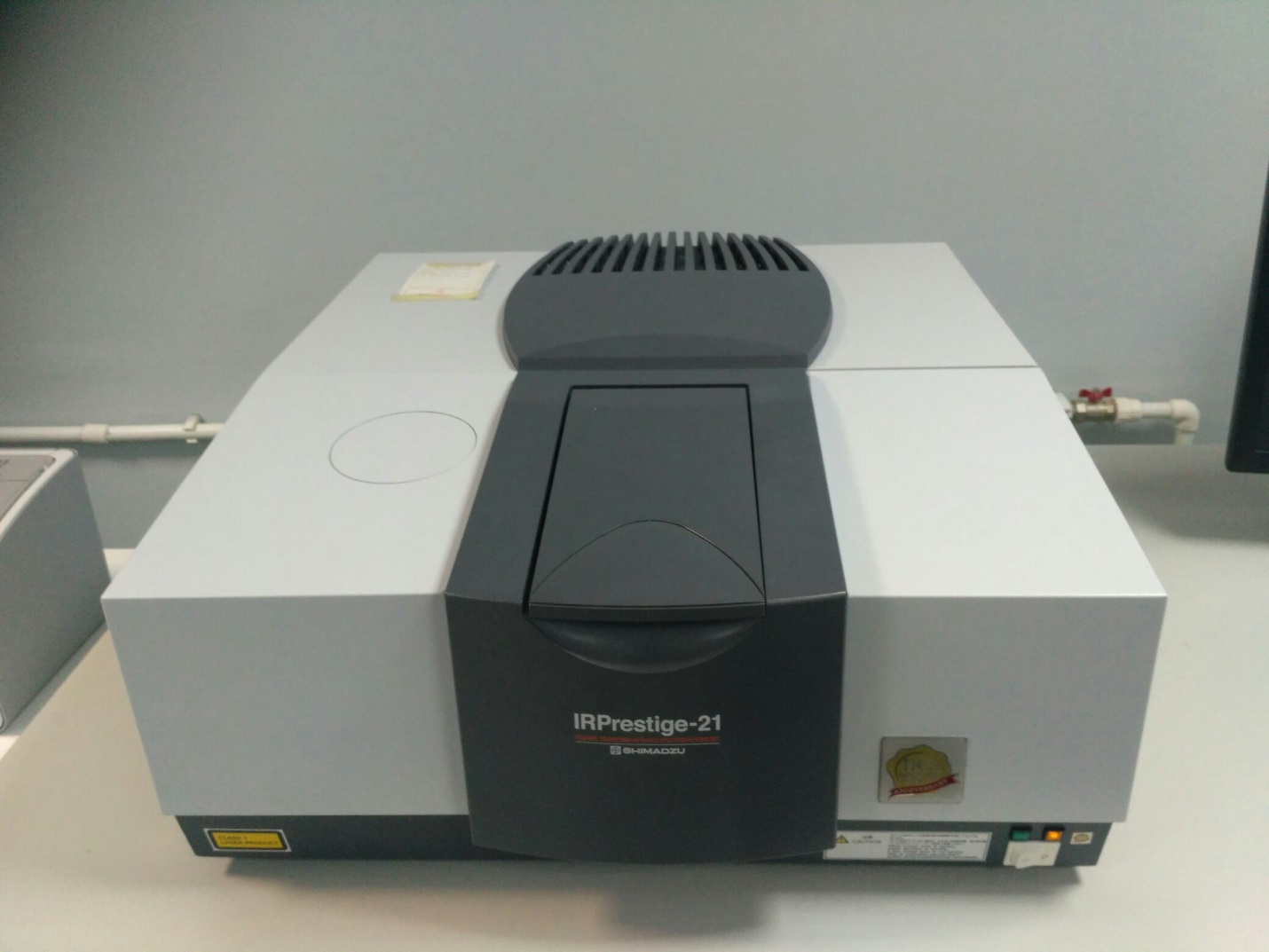
IIRPrestige-21 is a high-end device, corresponding to the highest modern standards, thanks to, in particular, high sensitivity (signal to noise ratio of 40000: 1)
Specification:
Spectral range: 12500 ~ 240 cm-1
Optical scheme: Single beam
Excitation source: Bright Ceramic Light Source, halogen lamp.
Beamsplitters: КBr – КВr, CsI, CaF2.
Interferometer: fast-scan Michelson type with the adjacent corner 300 with an electromagnetic drive and a digital dynamic alignment. Sealed with humidity control
Detectors: DLATGS, InGaAs.
Resolution: 0,5; 1; 2; 4; 8 or 16 cm-1.
Signal/noise ratio > 40000:1
Posted in Научное оборудование
Spectrophotometer UV-3600 (Shimadzu)

Unique UV-3600 Plus spectrophotometer is designed to operate over a wide spectral range and is equipped with three detectors: a photomultiplier for work in the ultraviolet and visible region of the spectrum, semiconductor InGaAs and PbS detectors are cooled to operate in the near infrared range.
Specification:
Optical scheme: Double beam, double monochromator
Spectral range: 185-3300 nm
Detectors UV/visible range: PMT, NIR: InGaAs / cooled PbS
The width of the UV/visible range of slots: 8 speed; from 0.1 to 8 nanometers
NIR: 10 speed; from 0.2 to 32 nm
Resolution: 0.1 nm
Noise level: 0.00005 Abs or less (500 nm);
Or below 0.00008 Abs (900 nm);
Or below 0.00003 Abs (1500 nm)
The level of scattered light: 0.00008% (220nm, NaI); 0.00005% (340 nm, NaNO2); 0.0005% (1420 nm, H2O); 0,005% (2365 nm, CHCl3)
Photometric range from -6 to +6 Abs
Photometric accuracy: ± 0,003 Abs (at 1 Abs); ± 0,002 Abs (at 0,5 Abs)
The size of the sample compartment 150 * 260 * 140 mm
Posted in Научное оборудование
Raman spectrometer Horiba Jobin-Yvon LabRam HR800
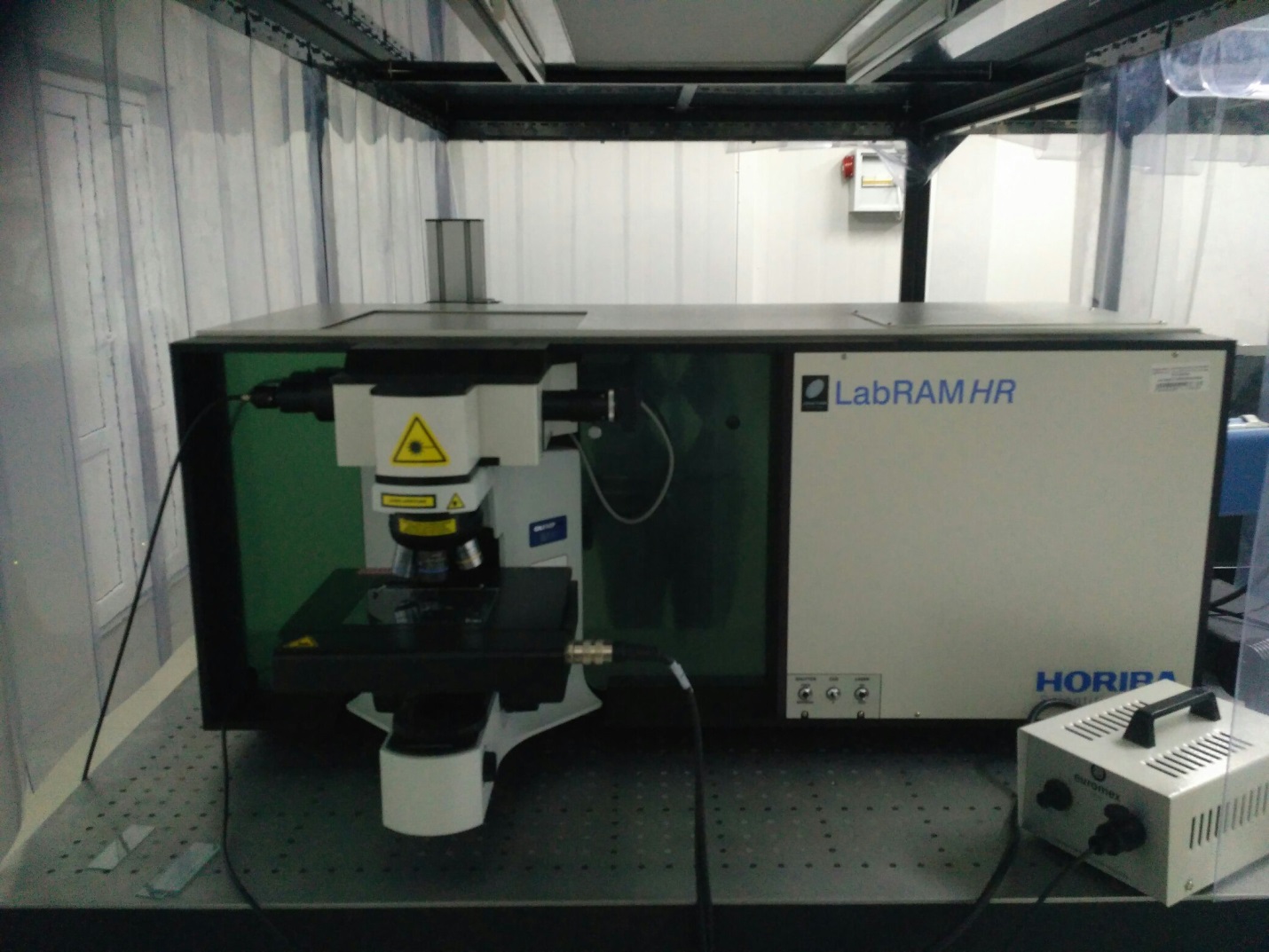
Raman spectrometer Horiba Jobin-Yvon LabRam HR800 used for registration of spectra of Raman scattering. A main aims are identification of the studied substances in solid, liquid or gaseous states, phase diagnostic of inclusions in minerals, assessment of the degree of crystallinity of the substance, studies the transformation of substances in the chemical and electrochemical reactions, studies of changes in biological tissues. A built-in microscope allows to obtain information with micrometer objects. Confocal optical scheme enables the most detailed images and analyses to be obtaibed with speed and confidence.
Specification:
Spectrograph: focal length is 800 mm; there are 3 diffraction gratings at 600 l/mm, 1800 l/mm
Spectral range: 4000-100 сm-1
Spectral resolution : up to 1.5сm-1
Accuracy of wavenumber: 1 сm-1
Spatial resolution: up to 1 micron
Lasers: tunable Ar+ laser with power up to 50mW and with notch filters at 488nm and 514 nm; He-Ne at 632nm and power up to 10 mW
Microscope: Olympus BX41with objectives 10Х (NA 0.25), 50X (NA 0.75), 50X (NA 0.5), 100X (NA 0.9)
Detector : Peltier-cooled CCD 1024Х256 px
Posted in Научное оборудование
Spectrometer UV-2550 (Shimadzu)
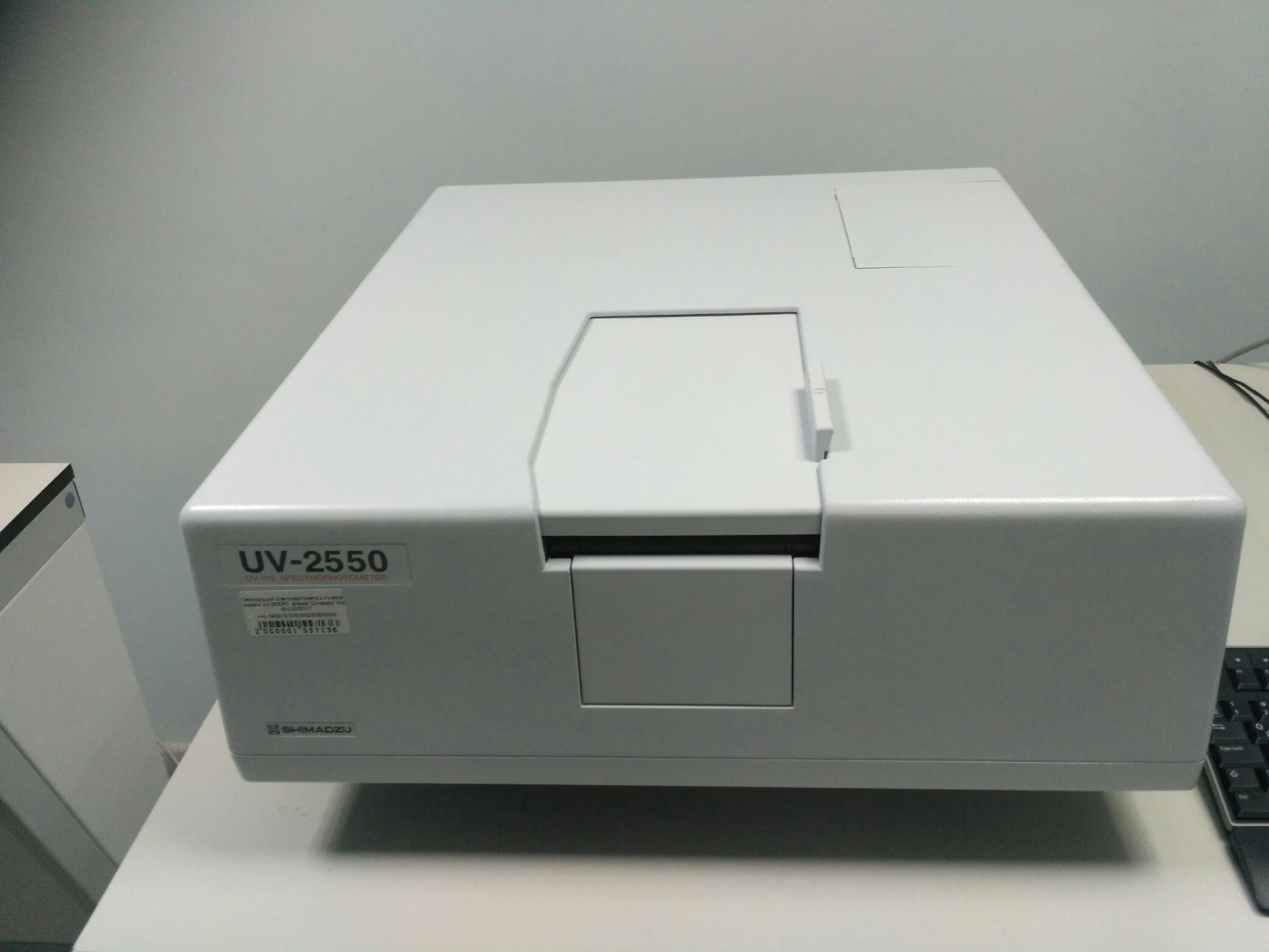
This device has unique characteristics:
- The lowest in this class of devices the diameter of the light beam, the resolution to 0.1 nm,
- The widest in its class photometric range from -4 to 5 Abs.
Double beam optical system ensures stable baseline, and allows the detection of minimal changes in the background, which is very important for colorimetric water analysis.
Spectrophotometer UV-2550 used in various fields of science and industry: organic chemistry, biochemistry, environmental monitoring, textile and food industries.
Specifications:
Monochromator: double
Spectral range: 190- 1100 nm
Spectral slit width: 0.1; 0.2; 0.5; 1; 2 and 5 nm
Resolution: 0.1 nm
Scattered radiation: <0.0003% T at 220 and 340 nm
Wavelength Accuracy: ± 0,3 nm
Reproducibility of wavelength: ± 0,1 nm
Photometry range from -4 to 5 Abs. and from 0 to 99.99% T
Photometric accuracy: ± 0,002 Abs. at a value of measurement from 0 to 1.0 Abs. ± 0,004 Abs. a value of the measurement of 0.5 to 1 Abs.
Baseline stability: less than 0.0004 Abs./ch (after 2 hour warm)
Scanning speed: 160 - 900 nm / min (3200 positioning nm / min)
Posted in Научное оборудование
Magnetooptical trap miniMOT™ Toptica Photonics
Magnetooptical trap MiniMOT ™ is a compact equipment, including vacuum cell with a vacuum pump, the dispenser of rubidium atoms, the magnetic coils, electronics and optical elements for creating a magneto-optical trap (MOT). MOT is a major instrument in most experiments with cold atoms.
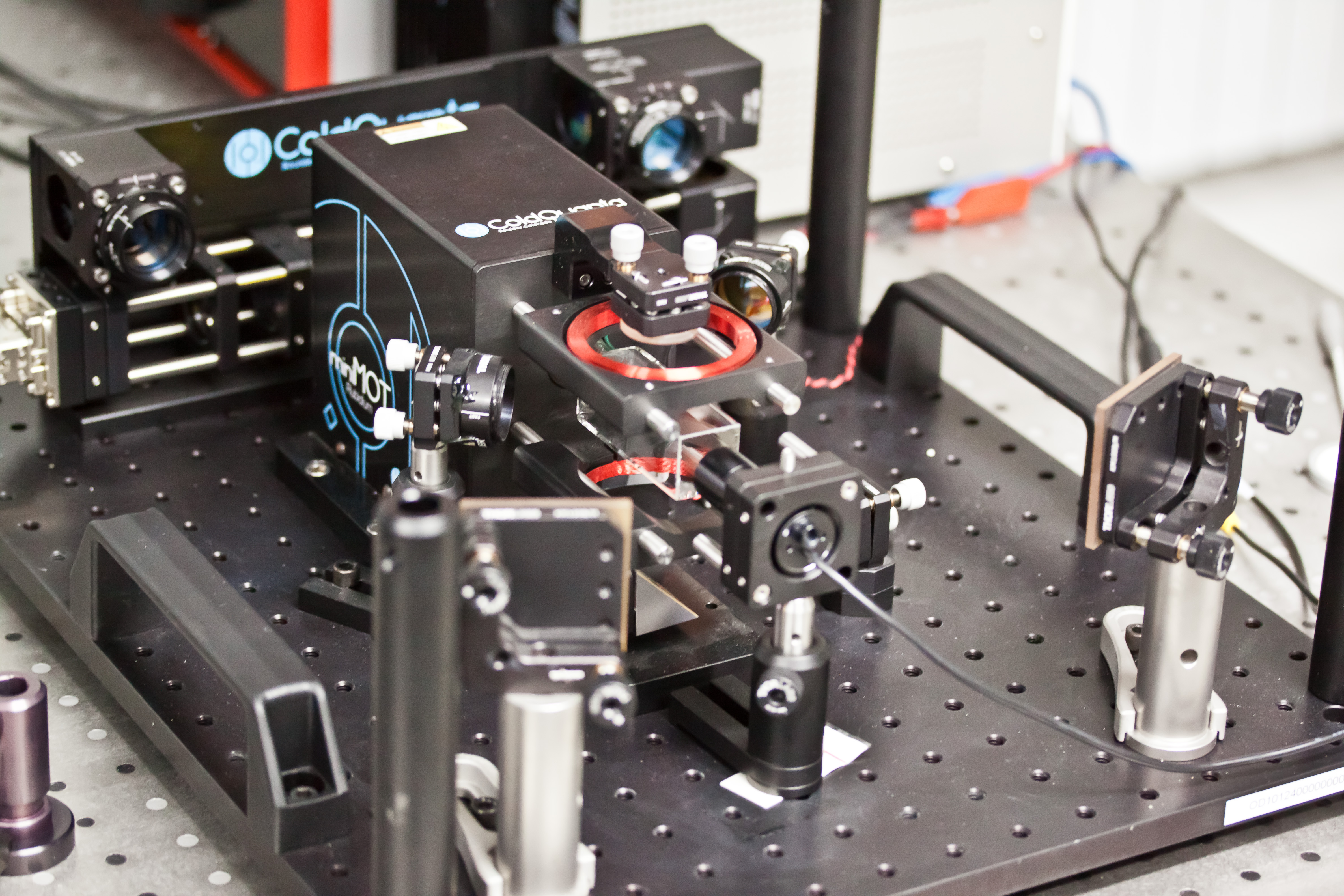
Figure 1 – Magnetooptical trap MiniMOT™
Additional equipment:
- tunable diode laser DL pro
- laser power booster BoosTA
- compact unit for absorption saturation spectroscopy CoSy
- feedback based digital controller for control, stabilization, synchronization and analysis of DigiLock 110 lasers
- universal PID controller PID 110
The operating principle of a magneto-optical trap
The operating principle of magneto-optical (MOL) is based on a combination of laser cooling in the configuration of the three pairs of counter laser beams and linear inhomogeneous magnetic field produced by a pair of Helmholtz coils in configuration with reverse currents (Figure). The laser field provides the friction force, which depends on the speed of atoms and leads to cooling, and the magnetic field creates a restoring force, which depends on the position of the atoms.
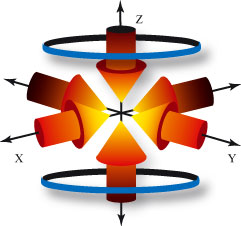
Figure 2 - The combination of laser cooling in the configuration of the three pairs of counter laser beams and linear inhomogeneous magnetic field generated by a pair of Helmholtz coils in a configuration with reverse currents
Laser cooling is based on the effect of radiation pressure force resulting from the transfer of momentum ħk light from the light wave to an atom in the absorption and subsequent spontaneous emission cycle. It is obvious that the deceleration of the atom would occur as a result of interaction with the counterpropagating wave. In addition, it must be noted that the absorption of laser radiation by an atom depends on the detuning frequency of the atomic transition and laser, resulting from the Doppler effect and from the velocity of the atom. Thus, the cooling of atoms in one spatial direction is achieved in the field of two counterpropagating laser waves detuned below the frequency of the atomic transition (red detuning).
Note that the cooling is achieved by a large number of "absorption-spontaneous emission" cycles. This means that for the realization of laser cooling an atom must have a special scheme of levels, such that after the "absorption-emission" cycle an atom always returned to its initial state. 85Rb atoms, for example, possess such closed transition between 5S1/2F=3 and 5P3/2F=4 states (Figure 3 (a) and (b)). The transitions from the excited state to the state 5P1/2 are forbidden by parity, and for the decay in the state 5S1/2 F=2 a change in the angular momentum of -2 is needed, and this requires more than one photon (Figure 3 (c) and (d)). However, since the cooling requires detuning of the laser frequency from the atomic transition, there is some probability of the atom excitation in the state 5P3/2F=3 (once in every 1000 cycles). If an atom is excited in this state, it can decompose into the state 5S1/2F=3 or "dark" state 5S1/2F=2. In the latter case, the atom ceases to make cycling transitions and cooling ends. To continue the cooling, an additional overpumping laser resonant to the transition 5S1/2F=2 → 5P3/2F=3 must be used.

Figure 3 – 85Rb atoms absorption scheme
Taking into account the multilevel of atoms, radiation pressure force can be spatially modulated using circular polarized light and magnetic field gradient generated by two coils. Consider an example of one-dimensional trap (Figure 4). It consists of two counterpropagating laser beams with opposite circular polarizations, interacting with the transition between levels with Jg = 0 and Je = 1. In addition, the static magnetic field influences on atoms; the magnitude of this field is proportional to the distance x from the center of the trap x=0: B = bx.
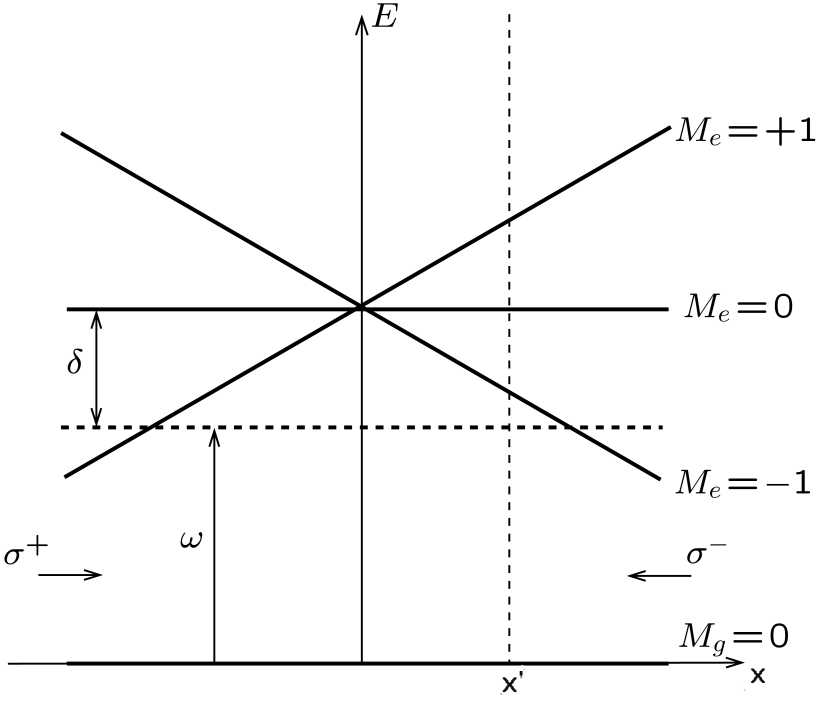
Figure 4 – an example of one-dimensional trap
Let at zero magnetic field laser fields detuned on the value of d lower than the atomic transition between levels Jg = 0 and Je = 1. In a magnetic field atomic levels split and shift (the Zeeman effect). As a result, Je = 1 level splits into three sublevels with Me = 0 and Me = ± 1. In the region where x> 0, and B> 0, Me = +1 level shifts up, while the Me = -1 level shifts down. To the left of center of the trap, the opposite pattern is obtained. Thus, at the point x + right from the trap center the magnetic field adjusts closer to the resonance transition with DM = -1, and the transition with DM = +1 is detuned further from resonance.
In order to capture the atoms at the center of the trap, where the magnetic field is zero, it is necessary to organize the interaction between the atoms and a laser field so that the field pushes them in the direction of x = 0.
It is known that the efficiency of interaction with the atoms field in states Me = ± 1, depends on the direction of their movement and field polarization. Thus, atoms in a state with Me = -1 most efficiently interact with the polarization s+, if they move in the direction of the laser beam, and with the polarization s-, when moving towards the beam. For the state with Me = +1, everything happens on the contrary. Then, to create the force acting upon atoms, which pushes them towards the center of the trap, it is necessary to select the polarization of the laser beam incident on the right with s-, and left with s+. In this case, the atoms moving in a positive direction of the x axis will effectively interact with the wave s-, scattering the light from it and gaining momentum in the opposite direction of their movement. The atoms that move in the opposite direction will weakly interact with the two waves, until they fall in the region to the left of the origin, where the levels Me = ± 1 reverse roles. Now more light is scattered from waves s+, again leading to the appearance of force pushing the atoms towards the center.
Experiments with MOT
MOL provides preliminary cooling of the atoms ensemble to produce Bose-Einstein condensates and degenerated Fermi gases, for precision spectroscopy and frequency standards based on atomic fountain. Despite significant progress in the cooling of atomic gases cooling problem of the complex particles ensembles remains relevant. In connection with this fact, the search for universal cooling methods which do not depend on the inner structure of particles is conducted. Particularly, the use of a feedback method based on measuring the reverse Bragg scattering signal is very perspective [J. Phys. B 47, 135303 (2014); JETP Lett. 100, 536 (2014); JETP (2015)]. At the method design stage it is reasonable to use atoms as test particles, preliminary cooled in the MOT. Such application of the MOT, available in the Center for Optical and Laser Materials Research, is supposed, for example, in the project 11.38.640.2013 within the Event 2.


 English (UK)
English (UK)  Русский (РФ)
Русский (РФ) 





